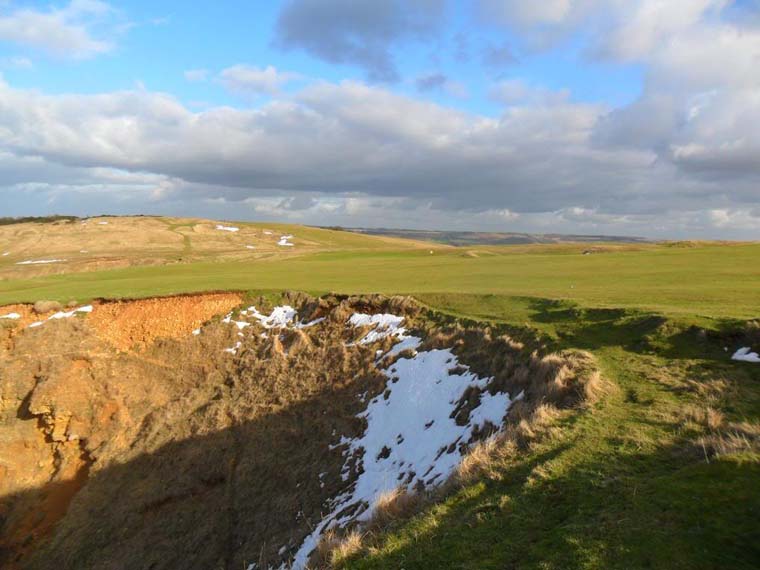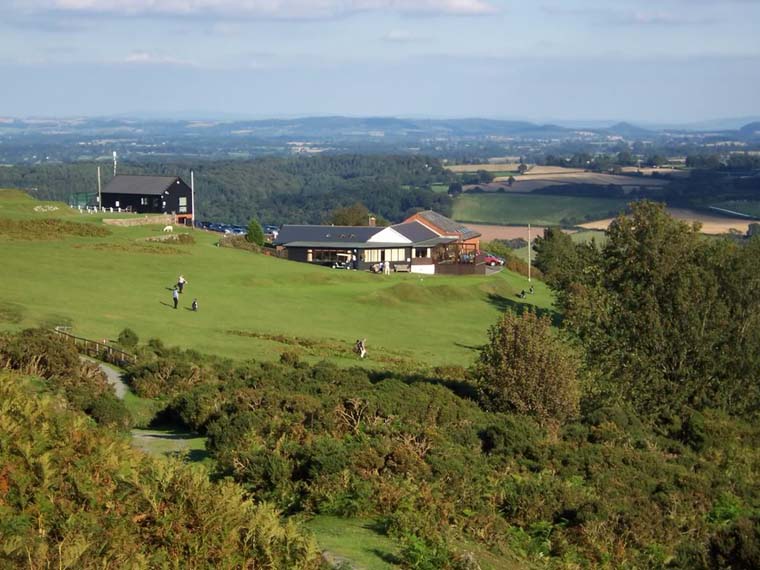A Dream Course II
by
Sean Arble
September, 2014
‘…we should urge Sean Arble to do one only he can – the 18 best holes from the UK that none of us know!’
Ran threw down a challenge to create my own eclectic 18. As seen above, the conditions were short, sweet and nigh on impossible considering the crowd that hangs out at GolfClubAtlas! As a compromise, I decided to only use English and Welsh courses. I was therefore immediately stripped of the services of Strandhill, Burnside, Portsalon, Narin & Portnoo etc etc. If I was in doubt, my final decision to strike a course from consideration was based on if there was a Ran Review or if I knew Ran had played the course. And so, I lost a handful of excellent candidates from Huntercombe, Little Aston, Pennard and Notts. As this is an ideal eclectic, I wanted certain elements which make the course very personal. A brief survey of these factors includes:
1. A short course by modern standards. One which is fun, but plays tough for its yardage.
2. I wanted at least one driveable par 4 and at least one more that in theory is reachable.
3. In addition to the very short 4s, I very much enjoy the odd drive and pitch hole. This was easy to find as Berkhampsted has just the thing for its opener.
4. Interesting, smash mouth two-shotters are immensely fun, but fairly rare. I was keen to include a few such examples and did so with holes from Seascale and Sutton Coldfield.
5. It is often the case that amidst all the rolling and tumbling land, golfers lose sight of simple, yet very satisfying holes. Whittington Heath’s 14th seems to me a fine example of the type.
6. It was always going to be the case that at least five par 3s would be on the card. My goal was to have a very short and a very long one-shotter. I believe the 15th from Cavendish and the most unusual 10th from Temple fulfil the requirement more than adequately.
7. I am not overly bothered about par 5s, but the inclusion of only one may be a bit light. I simply couldn’t find another hole I wanted to sacrifice for a 5, so went the way of Cavendish’s 14th.
As is always the case with these sorts of lists, the compromises are almost too much to bear. It is hard to fathom the agony an architect may have if he knows one of his stars will not work into the mix. This is how I lost the Sacred 9’s fifth. Enough of the qualifiers; publish and be damned.
One of the oldest clubs in Hertfordshire, Berkhampsted is tucked away in the north Chilterns and was originally designed by founding members of the club then significantly altered by James Braid between 1923 and 1926. In Golfer’s Companion, Frank Pennink writes holes 4-9 are Braid’s. While lacking in bunkers, the course does on several holes utilize Grim’s Ditch (Grim being a generic Anglo-Saxon term for the unexplained) to great effect. The origins of the ditch(es) are thought to be about 2300 years old, but it isn’t known why they were built.
The shortish 1st hole is all of 317 yards, but holds great promise as Grim’s Ditch makes an immediate short, sharp appearance. Driver is a dangerous play, but hazard is angled to tempt the player.

One of the best aspects of the ditch is the variable lies which can be drawn. This fact may lead golfers to be overly greedy.
Onto the crazy 501 yards which make up the 2nd, but in truth the hole is no crazier than about half dozen other holes at Perranporth.
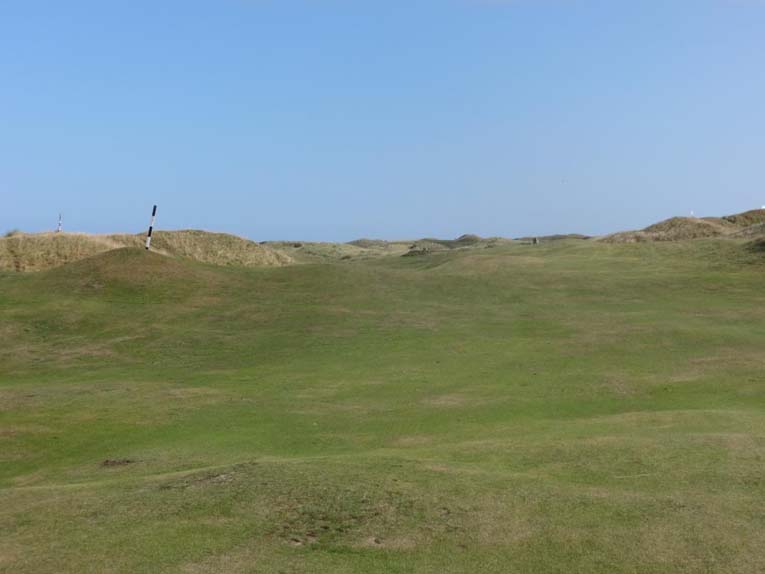
The direct line to the green is left of the markers, but how much carry is there? For that matter, how far does one hit a lay-up?

If one is fortunate he will emerge from the bumps with a ball in play. All is not yet earned though. The green swings madly left making the successful bold player a leg up.
Sevenoaks, a smart London bedroom community in Kent, is probably most famous for six of its specially planted seven oaks being uprooted during the Great Storm of 1987. The six were replaced amid a media storm of its own shortly afterwards! Though, for most of us, it is hard to see what all the fuss is about as there are countless oaks scattered about Knole Park’s 1000 acres. Yes, the course is situated within Knole Park, but one doesn’t have any sense as to what he may encounter during the round. Climbing from the valley bisecting the 6th, the magnificent Knole House gradually reveals itself. Made of traditional Kentish ragstone, the immensity of the structure is difficult to fathom. Seat to the Barons Sackville, Knole House is now open to the public, however, most of its 356 rooms are privately owned. As would be expected for such an iconic building, many bits and bobs of films and tv programs have been filmed around the grounds of the house; including The Beatles’ Penny Lane and Strawberry Fields Forever videos.
Opened in 1924 by the 3rd Lord Sackville, Knole Park GC was designed by J Abercomby with James Braid as consultant. A caddie for the exhibition match was one young Sam King, Knole Park’s most famous son. Long time professional to the club, Mr King was born just down the road from Knole Park. He finished in the top 10 nine times while playing in every Open held between 1932 and 1962. Finishing four shots behind winner Dick Burton in 1939, this was the last Open played until 1946. WWII cut short the careers of several fine players who may well have made a bigger mark in the game. 1939 also saw the cancellation of the Ryder Cup, the second of which Mr King was selected as a competitor. In all, Sam King played in three Ryder Cups (1937, 1947 & 1949) and recorded the only point earned for Great Britain & Ireland during the 1947 matches in Portland.
Knole Park starts as if shot from a canon for the opening six holes covering some testing terrain. The 393 yard third is on view while walking up the second, but it isn’t until after hitting the drive and walking forward some 100 yards that the hole is properly unveiled. I want folks to have the same sense of awe as I did when I first encountered the hole…so no photo.
4th hole Church Stretton 421 yards
Naturally, after facing what must make a strong argument for the three funkiest par 3s in succession, anywhere, we now come face to face with Church Stretton’s longest hole. However, it isn’t the length which causes too much alarm. It is rather the epic nature of the design which takes us tightly alongside a valley ridge for the drive then over the valley the approach.

The green can be seen out to the right. I don’t believe the original designers had much notion that folks would go for this green in two. The fairway plunging madly down the hill on the right is the insane 15th.
Borth and Ynyslas is located in the mighty dunes of Ynyslas, which are part of the Dyfi National Nature Reserve. The 304 yard fifth takes us to the most interesting part of the course on the edge of dunes. The drive is cut-off by low mounding at about the 260 mark of this short par 4. I suspect the mound between the bunkers was added at some point. In the rear left is #12 green. It would have been cool to create a double green.
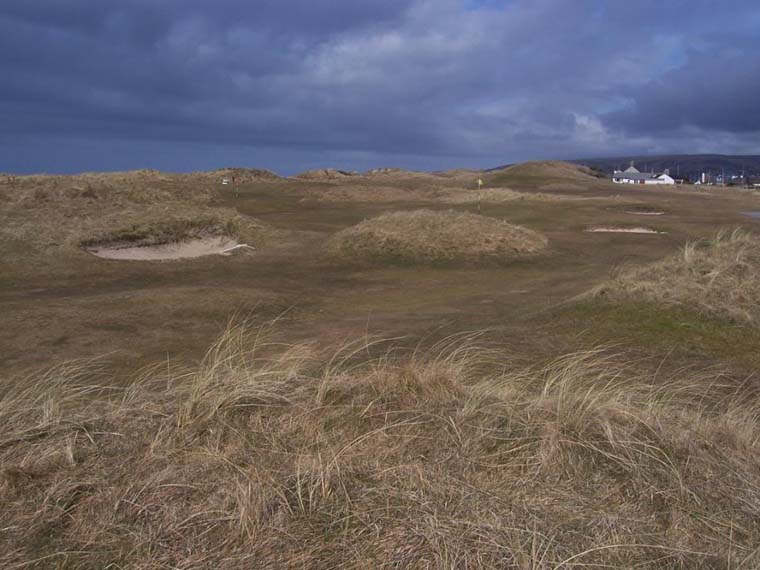
Numbers don’t really describe Painswick very well, but I offer them in the hope that prospective golfers will be intrigued. From the medal tees, the course is less than three miles long or to be exact, 4831 yards. Seven one-shotters are featured making a total par of 67. During one six hole stretch between #s 5 and 10 there isn’t a par 4 to be found. The daily tee on the seventeenth is one yard longer than the medal tee. Oh yes, there is only one bunker on the property and it is strictly for practice. Perhaps most eye opening of all, as the SSS is 64, the five marker must shoot 69 to properly maintain his handicap. Believe me, this is no easy feat when one must play difficult, yet superlative such as the 202 6th. Left is the would be 6th fairway; right is the equally elusive 11th fairway.
Sutton Coldfield GC is laid out on the extreme western edge of the immense Sutton Park, a mere seven miles from Birmingham city centre and quite near Icknield St (an old Roman road) down the 13th fairway . At over 2000 acres in size, Sutton is one of the largest urban parks in Europe. A significant section of the park is natural heathland and this is where the club chose to build its course just before the turn of the century. Dr Alistair MacKenzie submitted a proposal to redesign the course in 1919. The basics of this plan remain today with some major alterations including all the fairway bunkering being removed.
I can’t understand why the club would ever dream of playing the Winter Course’s 439 yard 7th hole as anything but the long, tough, demanding par 4 that it is in the winter. As the hole turns against the grain of the terrain, it is essential to keep as far right as possible even if it requires a lay-up.

The green is set at a perfect diagonal benched into a hill. The entire package makes this hole nothing short of one of the finest in the Midlands.
Hanging on the western Cotswold escarpment over-looking the Vale of Evesham and the Warwickshire Avon lays Broadway GC. The famous town of Broadway was once, like much of the Cotswolds, heavily reliant upon the wool trade. The main source of income these days is tourism rather than wool. Since Victorian times with the coming of the railroad, a great many well heeled English gentry have maintained second homes in the Cotswolds and near Broadway in particular. The golf course is set near the summit of Willersey Hill at an elevation of 850 feet and affords some of the most scenic views to be had in the Cotswolds. If one is lucky he will catch a glimpse of Royal Air Force jets practicing manoeuvres below the course.
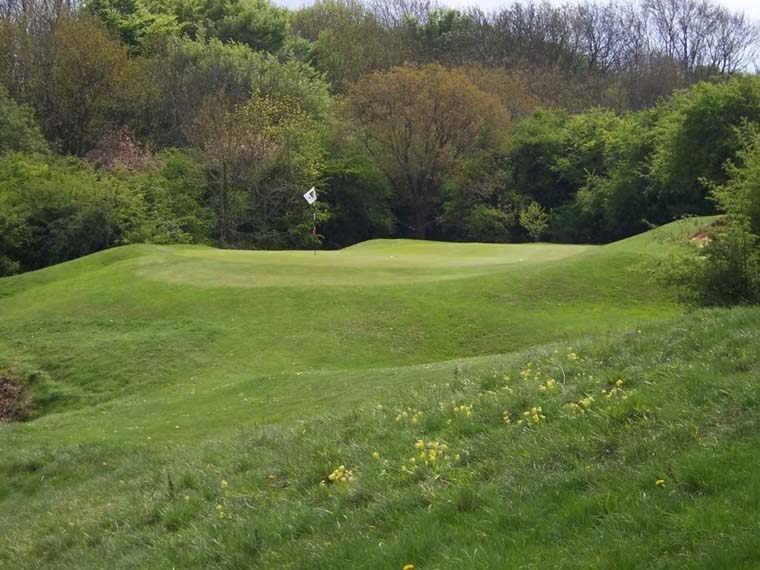
While the 128 yard 8th hole doesn’t offer a terrific view, it does provide for a demanding tee shot. The hole plays a bit uphill to a narrow green with no room to miss left. The front flag doesn’t look a particularly inviting target.
9th hole, Beau Desert, 252 yards: Chef-d’œuvre. Photos don’t do the hole justice.
As was often the case for English courses designed around the turn of the century, the choice of architects was among a trio of HS Colt, Willie Park Jr or Herbert Fowler. Having designed nearby Huntercombe and Sunningdale it should come as no surprise that double Open champion Willie Park Jr was selected to lay out Temple in 1909. The course was originally called Temple Links because it was designed to play as an inland links and the land was previously owned by the Knights Templar. Despite modern technology, the presentation of Temple is still characterized by the season. Being located on chalk downland the course does feel somewhat similar to a links, but the commanding views of the Thames Valley surely give Temple a sense of place that is rarely matched.
The Oppenheimer father-son duo reigned at Temple as benevolent dictatorship for several decades. The younger Oppenheimer was a fine golfer and captained the 1951 Walker Cup side which was defeated at Royal Birkdale. Oppenheimer was also responsible for hiring the best British golfer of the day, Sir Henry Cotton, as the club’s professional. Cotton believed the turf at Temple was outstanding. As was the case for many British clubs, a watering system was installed in the 70s. At the time, the implications of this modern convenience weren’t totally understood. The heavy use of water and fertilizers altered the character of the course from a downland to more of a parkland course. Thanks to a forward looking board in the early 90s, Temple became a leader in promoting sustainable golf which aims to encourage fine grasses to prosper by dramatically reducing fertilizer and water usage. The story of this change in course management culture is chronicled in Confessions of a Greens Chairman by Malcolm Peake, the former Greens Chairman.
The back 9 opens with what is without a doubt the most unique blind par 3 I have ever come across.

When I first saw the hole I thought it was a long par 5 (see green to the left), but then we discovered another set of tees further up and decided to investigate by looking at the card. It is hard to believe there is a green tucked out in that field, but there is one most certainly at about 235 yards out.

In a strange sort of way, the hole reminds me of a macro version of putting into a hole. One blasts a shot out there and hopes it collects into the completely blind bowl. I can imagine many not liking this hole, but it is akin to sprouts. There is no use in complaining. The damn things are on the plate so they must be eaten.
Minchinhampton Old is an open grassland course 600 feet above sea level with panoramic views of the Cotswolds. Opened in 1889, the course is situated on the magnificent Minchinhampton Common; the nearest bigger towns to the course are Nailsworth and Stroud which lie in the valley below. I believe membership of the Old Course can be obtained separately from the main club which has two newer courses, one built in the 70s and the other in the 90s. The bunker free Old Course has a combination of original holes mixed with some new holes and a bit of oddly out of place modern shaping around some greens. There is very little shaping in the fairways, only the odd turf dyke. Despite the lack of shaping, there is no question the designers knew what they were doing as the angles presented bear the hallmarks of strategic golf.
My favourite aspect of Minchinhampton is the true common feel of the course. The course circles in a wide arc around the 580 acre common and through the remains of an Iron Age fort. There is a long tradition of golf on common land in England, but Minchinhampton feels unique to me. The course crosses several roads while sharing the land with walkers, horses, children at play and cows. This is the first time I have had the pleasure to experience a true common golf scene as one might have found 120 years ago. There are open views in every direction, but many of the holes have a strangely semi-blind nature, especially from the tee. Usually this is due to slight rises in fairways. Of course, there are no bunkers and few trees to act as guides or help with estimating distance.
The 414 11th hole celebrates Tom Longs Post which is the road sign behind the green. This post is used in the Old Course’s logo. Take dead aim over the trees then fire away at Tom Longs Post. Stroud Brewery brews ale called Tom Long, named after a mythical highwayman hung and buried at Tom Longs Post.
One of the many wonderful aspects of living in England is the ever present history of the country. Often times golf courses are not excepted and at Yelverton a main feature of the course is one of the oldest municipal supplies of water in England. Drake’s Leat was built in 1591 to supply water from The River Meavy on Dartmoor to Plymouth. Being the rogue that Drake was and using his power as Mayor of Plymouth, he made a healthy profit of £140 on the project. The clever construction of the leat meanders for seventeen miles and ran at such a gradual pace so as to minimize erosion. Originally the leat had stone floors and walls, but eventually most of the stones were removed and used in the construction of buildings. There is an old stone barn next to the 9th tee which in all probability is evidence of this thievery.
The outstanding 167 yard 12th is a puzzling sight from the tee. There is a runway feeding to the green from the left flanked by a large hillock to the right and the ever-present alps housing sand on the left. I think the best shot is a somewhat flat mid-iron utilizing the runway. I may be wrong, but I don’t think the green would normally hold a direct blow.
Located in the hilly southwest section of Birmingham, Harborne is a Colt course with many admirable holes. The original plan of the redesigned course was first submitted by the then firm of Colt, Mackenzie and Alison in 1922. While some corridors of the old course were used and the 12th green retained, there can be little doubt that Harborne is vintage Colt.
The 384 yard 13th is a corker which takes us blindly over the brow of a hill with this view awaiting.

The approach is what I call do or don’t die. For sure this is a heroic approach, but coming up short still leaves a recovery. From here the severity of the slope to be carried is more evident.
Whittington Heath is one of the older clubs in England being founded in 1886 near Litchfield, birthplace of Samuel Johnson. Before becoming a golf course the area was used for horse racing. The road on #6 is evidence of the old track and the clubhouse still retains the shape of a racing stand. Being next door to Whittington Barracks, the course was originally for military personnel. After some time civilians were allowed access and eventually the Ministry of Defense sold the course to the members in 1994. In 1927 HS Colt redesigned some of the front nine using the existing corridors for the current 1-3 and 6-8. All but the 18th on the back are original Colt holes.
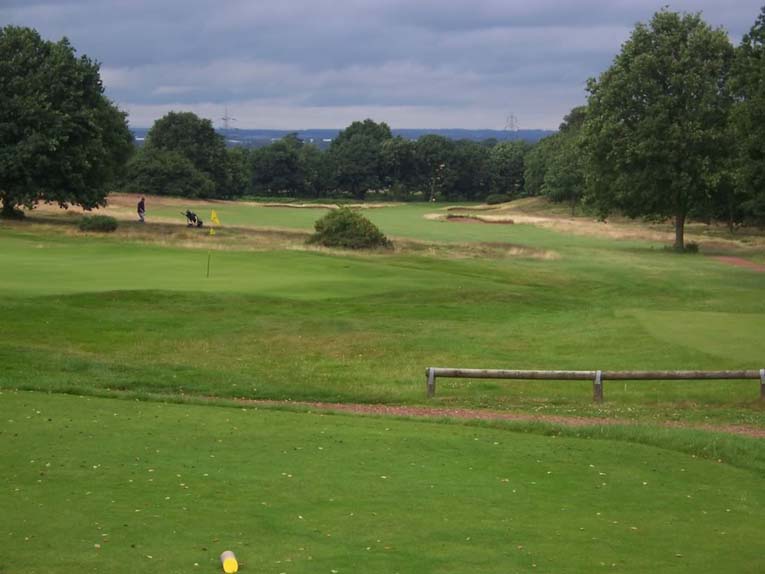
The back 9 is loaded with lovely holes and the 427 yard 14th is no exception. The hole slides gently right and downhill. Yes, the green falls away from the fairway, but Colt kept things reasonable as the slopes are manageable.
The green also moves against the grain of the dogleg by sloping right to left. The reader has probably noticed the eyebrows on some bunkers. The club had a terrible problem keeping rabbits at bay and apparently, the wispy grass was thought to be a solution. Well, all the grass has been removed and the terrible rocky sand has been replaced by much improved sand.
Located on a very well used ridge (an old railroad embankment), the Cavendish’s stellar 108 yard 15th has a hint of an Eden about it.
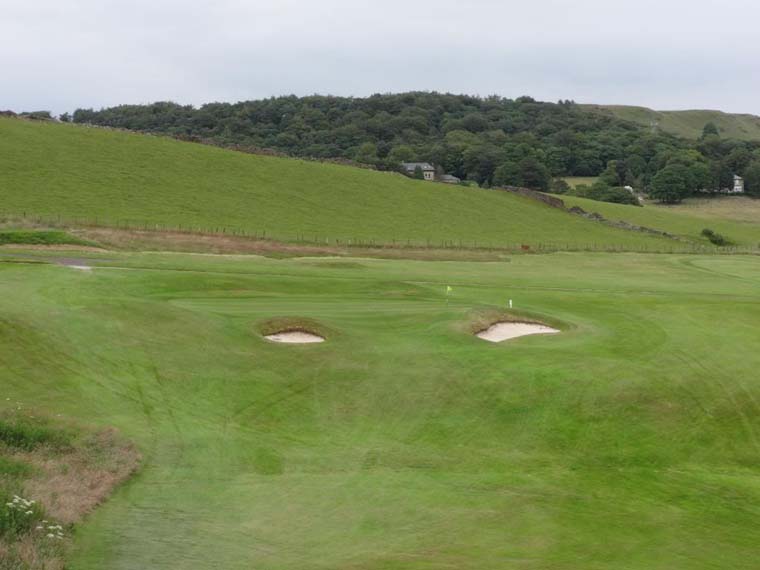
The pitch of the green pushes balls back down the hill toward the front bunkers. Any approach landing halfway up the slope of the green will do well to stay on the dance floor.
It is rare to get two truly outstanding holes on a links so little known such as Seascale, but with the ninth and 431 yard 16th that is exactly what this course provides. A monumental hole, the 16th plays over the lowest level in the valley of the shadow of a large dune on the left. The railroad embankment is to the right.

Playing steeply uphill and requiring a very precise second, this hole must measure up as one of the most fearsome par 4s in England.
We finally come to what I think is the finest finishing hole in golf. It isn’t often that a significant percentage of handicap golfers can stand on the tee of a par 4 and aspire to a 3. However, on many days this is exactly the goal on Kington’s 268 yard 18th.
There are several aspects of the final design which stand out. First, upon tallying up the numbers, I was very surprised the course fell far short of 6000 yards. I was sure the course would break the 6000 yard mark. As it is, the course is 5781 yards in length from the (in praise of) daily tees and par is 68. I was sure the course would at least break the 6000 yard mark. I am, however, confident there is enough challenge and opportunities for big hitting that most golfers would enjoy their day.
Second, by complete chance I managed to include nearly all the cream of the British architectural crop. Given my affinity for Colt, Fowler and Braid it shouldn’t have been unforeseen that these three would be well represented. Third, there are only three links holes included in the course. This is an indication of how difficult it is find courses with which a very large percentage of GCAers are not acquainted!
Finally, and again, without a determined plan to do so, the course very much follows my belief in the importance of terrain. There are approximately 20 bunkers on this course and eight holes are free of sand. It is my hope that going forward architects will seek to incorporate a much better variety of features. This likely means architects will have to become much more savvy in creating interesting architectural elements which are attractive.
One of the more gratifying aspects of an exercise such as this is that nobody would choose the same holes and in a year I may devise a course which has little resemblance to this example. With this thought in mind, and in the same spirit Ran issued his challenge, I am sure many of us would very much appreciate a Tommy Naccarato Dream California Course. Let’s hope Tommy takes up the challenge.
The End





